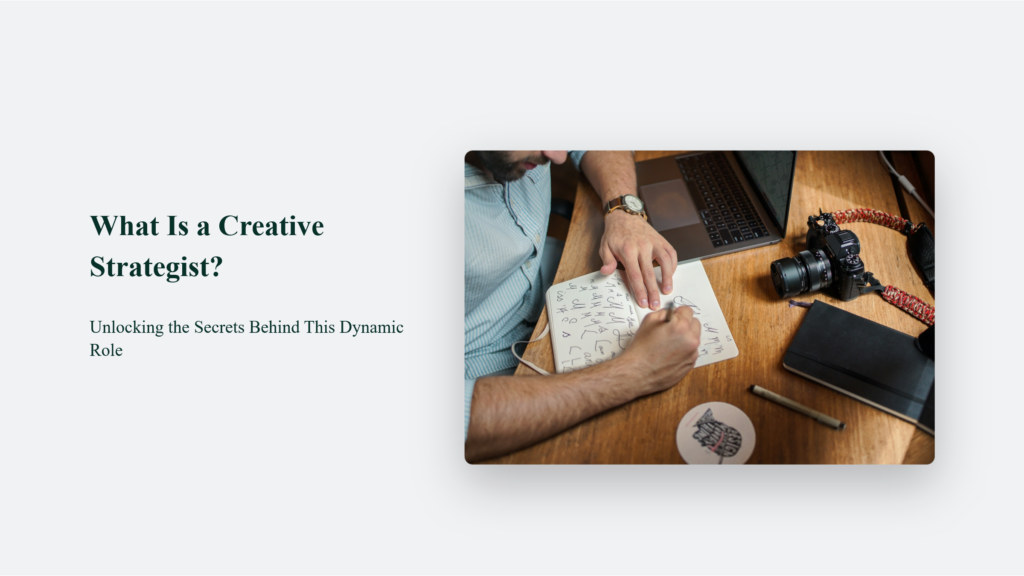

What Is a Creative Strategist? Unlocking the Secrets Behind This Dynamic Role

As Seen On
In today’s fast-paced and ever-evolving business landscape, the role of a creative strategist has become increasingly crucial. These innovative professionals bridge the gap between creativity and strategy, helping companies develop compelling campaigns and experiences that resonate with their target audience. But what is a creative strategist, and why are they so valuable? Let’s dive in and explore the fascinating world of creative strategy.

Table of Contents
What Is a Creative Strategist?
At the core of a creative strategist’s job is the ability to seamlessly combine creative thinking with strategic planning. They possess a unique skill set that allows them to:
- Understand the client’s business objectives and target audience
- Develop innovative ideas that align with the brand’s values and goals
- Craft compelling narratives that engage and inspire consumers
- Collaborate with various teams to bring concepts to life
By merging creativity and strategy, these professionals help companies stand out in a crowded market and forge meaningful connections with their customers.
The Creative Strategist’s Toolkit: Unlocking the Power of Creativity and Strategy
Creative strategists are the unsung heroes of the marketing world, seamlessly blending creativity and strategic thinking to develop campaigns that captivate audiences and drive results. To excel in this dynamic role, creative strategists must possess a diverse set of skills and tools that allow them to navigate the ever-changing landscape of marketing and advertising.
At the heart of a creative strategist’s toolkit lies a passion for research and analysis. These professionals dive deep into market trends, consumer insights, and competitor analysis to inform their strategies and ensure that their campaigns are grounded in data-driven insights. By understanding the nuances of their target audience and the competitive landscape, creative strategists can develop campaigns that resonate with consumers and set their brands apart.
But research and analysis alone are not enough to create truly memorable campaigns. Creative strategists must also possess the ability to craft compelling narratives that evoke emotions and create lasting impressions. Through the power of storytelling, these professionals can:
- Connect with audiences on a deeper level
- Communicate complex ideas in a relatable way
- Create a sense of urgency and inspire action
By weaving together data-driven insights and emotionally resonant narratives, creative strategists can develop campaigns that not only inform but also inspire.
By weaving together data-driven insights and emotionally resonant narratives, creative strategists can develop campaigns that not only inform but also inspire. However, even the most brilliant ideas cannot come to life without collaboration.
Creative strategists work closely with a wide range of teams, including:
- Designers who bring visual concepts to life
- Copywriters who craft compelling messages
- Account managers who ensure that campaigns align with client goals
By fostering a culture of collaboration and open communication, creative strategists can ensure that everyone is working towards a common vision and that ideas are executed flawlessly.
Perhaps most importantly, creative strategists must possess a keen sense of adaptability. In a world where consumer preferences and market trends can shift in the blink of an eye, these professionals must be able to pivot their strategies quickly and effectively.
Whether it’s embracing new technologies or adjusting messaging to reflect changing cultural norms, creative strategists must be nimble and responsive to stay ahead of the curve. By leveraging this diverse set of skills and tools, creative strategists can help companies navigate the complex world of marketing and advertising and develop campaigns that truly stand out.
From research and analysis to storytelling and collaboration, these professionals bring a unique blend of creativity and strategic thinking to every project they undertake. In a world where consumers are bombarded with countless messages every day, the role of the creative strategist has never been more important.
By unlocking the power of creativity and strategy, these professionals can help brands connect with audiences in meaningful ways and drive real results. So the next time you see a campaign that stops you in your tracks, take a moment to appreciate the creative strategist behind the scenes who made it all possible.
The Impact of Creative Strategy
The impact of a well-executed creative strategy cannot be overstated. It has the power to transform a company’s fortunes, propelling it to new heights of success and market dominance. The work of a skilled creative strategist is at the heart of this transformation, weaving together insights, imagination, and innovation to create campaigns that captivate audiences and drive results.
Consider these impressive statistics that demonstrate the tangible benefits of investing in creativity:
- Companies that prioritize creativity are 70% more likely to report having a competitive advantage. This is because creative campaigns help brands stand out in a crowded market, capturing the attention and loyalty of consumers.
- Brands that consistently deliver creative campaigns see a remarkable 10% increase in market share. By consistently pushing the boundaries of what’s possible and delivering fresh, engaging content, these brands are able to expand their reach and attract new customers.
Emotionally engaging campaigns, in particular, have been shown to have a profound impact on sales. Research indicates that campaigns that connect with consumers on an emotional level can increase sales by up to 23%. This is because emotions play a crucial role in decision-making, and campaigns that tap into the right emotions are more likely to inspire action.
But the impact of creative strategy goes beyond just sales and market share. It can also help companies build stronger, more resilient brands. By developing a unique brand voice and identity, creative strategists help companies forge deep, lasting connections with their audiences. This, in turn, leads to increased brand loyalty and advocacy, as consumers become emotionally invested in the brands they love.
Moreover, a strong creative strategy can help companies navigate times of crisis or change. In a rapidly evolving market, the ability to adapt and innovate is crucial. Creative strategists are uniquely positioned to help companies stay ahead of the curve, anticipating trends and developing campaigns that resonate with changing consumer needs and preferences.
Real-World Examples of Creative Strategy in Action
To better understand the role of a creative strategist, let’s look at some real-world examples of their work:
- Nike’s “Dream Crazy” Campaign: This powerful campaign, featuring Colin Kaepernick, was the brainchild of Nike’s creative strategists. By tapping into the cultural zeitgeist and taking a stand on social issues, the campaign generated massive buzz and solidified Nike’s position as a brand that stands for something bigger than just sports.
- Airbnb’s “Belong Anywhere” Campaign: Airbnb’s creative strategists developed this campaign to showcase the company’s unique value proposition: the ability to experience a destination like a local. By highlighting the authentic, immersive experiences that Airbnb offers, the campaign helped the company differentiate itself from traditional hotels and resorts.
These examples showcase the power of creative strategy in action and the impact it can have on a company’s brand and bottom line.
The Bottom Line:
In conclusion, the role of a creative strategist is a dynamic and exciting one that plays a crucial role in helping companies stand out in today’s competitive business landscape. By blending creativity and strategy, these innovative professionals develop campaigns and experiences that engage, inspire, and drive results. As the world continues to evolve, the demand for skilled creative strategists will only continue to grow.
Frequently Asked Questions:
What skills do I need to become a creative strategist?
To become a creative strategist, you’ll need a blend of creative thinking, strategic planning, and strong communication skills. A background in marketing, advertising, or a related field is also helpful.
What’s the difference between a creative strategist and a marketing strategist?
While both roles involve strategy, a creative strategist focuses specifically on developing creative concepts and campaigns, while a marketing strategist takes a broader view of a company’s overall marketing efforts.
How do creative strategists stay up-to-date with industry trends?
Creative strategists stay informed by attending industry events, reading trade publications, and participating in professional development opportunities. They also keep a close eye on cultural trends and consumer insights to inform their strategies.
Konger
Up until working with Casey, we had only had poor to mediocre experiences outsourcing work to agencies. Casey & the team at CJ&CO are the exception to the rule.
Communication was beyond great, his understanding of our vision was phenomenal, and instead of needing babysitting like the other agencies we worked with, he was not only completely dependable but also gave us sound suggestions on how to get better results, at the risk of us not needing him for the initial job we requested (absolute gem).
This has truly been the first time we worked with someone outside of our business that quickly grasped our vision, and that I could completely forget about and would still deliver above expectations.
I honestly can't wait to work in many more projects together!
Disclaimer
*The information this blog provides is for general informational purposes only and is not intended as financial or professional advice. The information may not reflect current developments and may be changed or updated without notice. Any opinions expressed on this blog are the author’s own and do not necessarily reflect the views of the author’s employer or any other organization. You should not act or rely on any information contained in this blog without first seeking the advice of a professional. No representation or warranty, express or implied, is made as to the accuracy or completeness of the information contained in this blog. The author and affiliated parties assume no liability for any errors or omissions.

